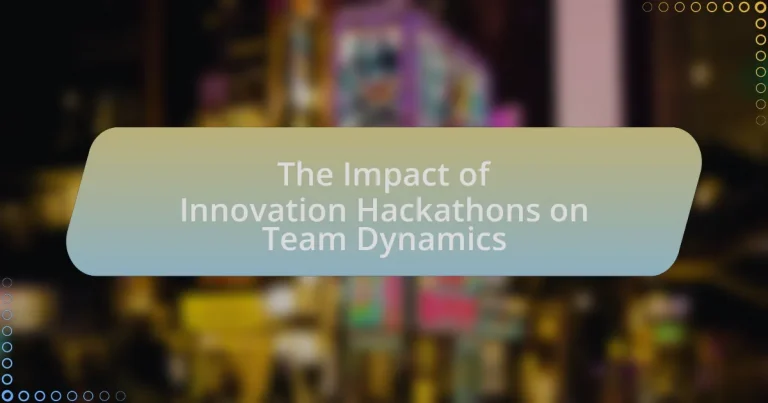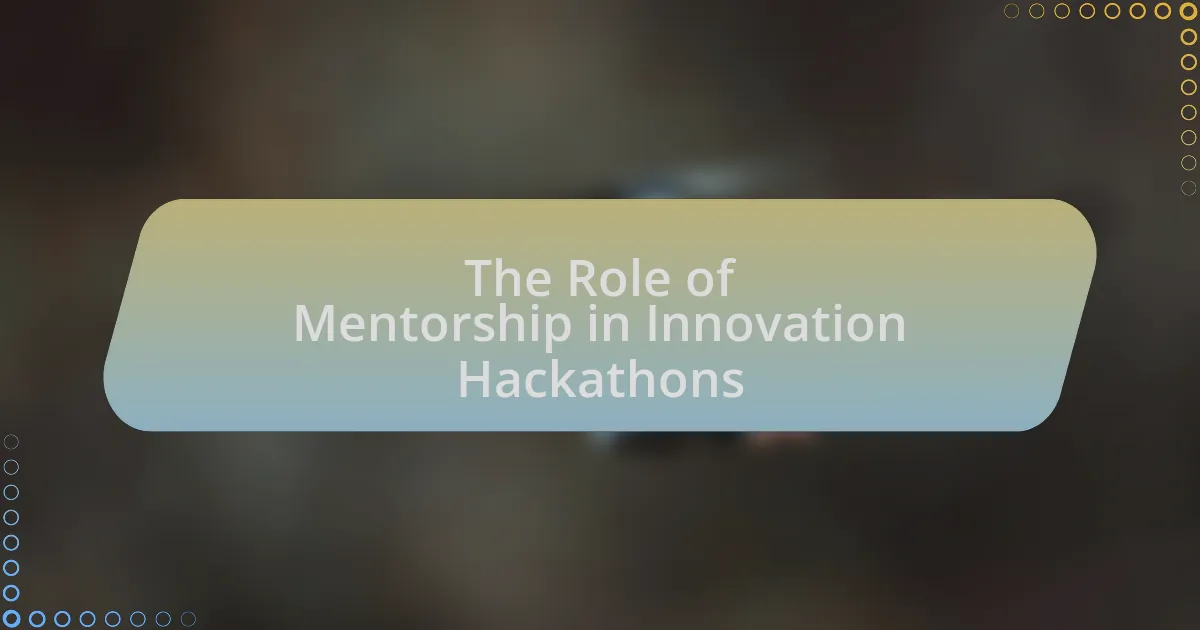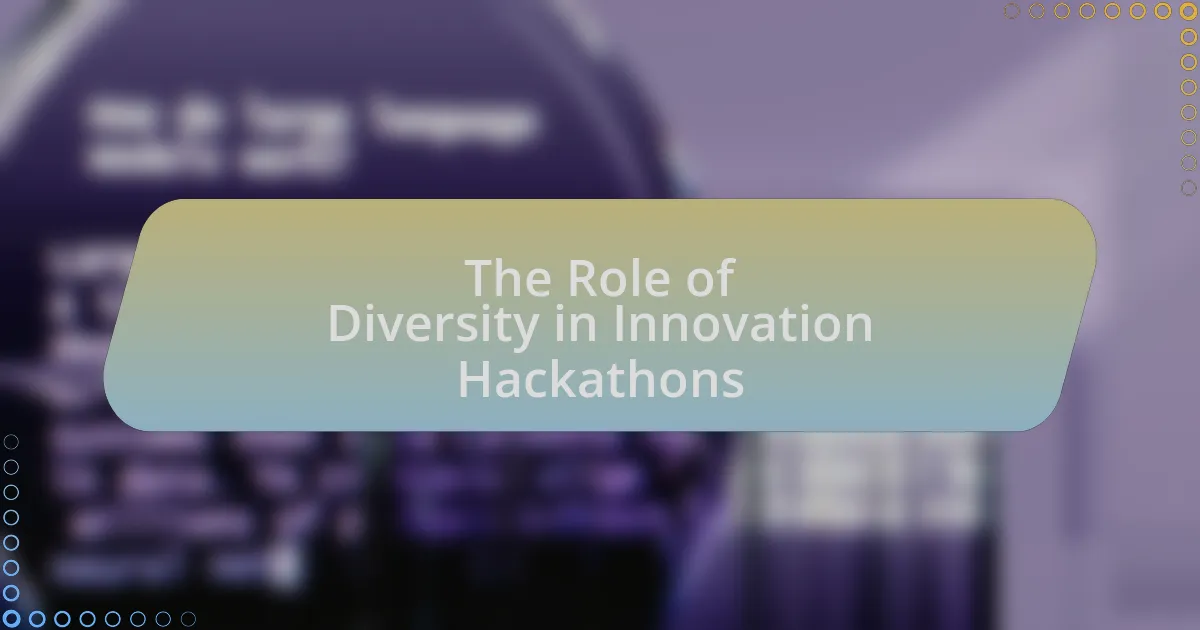Innovation hackathons are structured, time-constrained events designed to foster creativity and collaboration among diverse teams, leading to innovative solutions for specific challenges. This article explores the impact of innovation hackathons on team dynamics, highlighting how these events enhance communication, problem-solving skills, and interpersonal relationships among participants. Key activities involved in hackathons, such as brainstorming, rapid prototyping, and solution presentation, are examined, along with the long-term effects on team cohesion and collaboration. Additionally, the article discusses the challenges teams face post-hackathon and best practices for maintaining momentum and leveraging hackathon experiences for future projects.
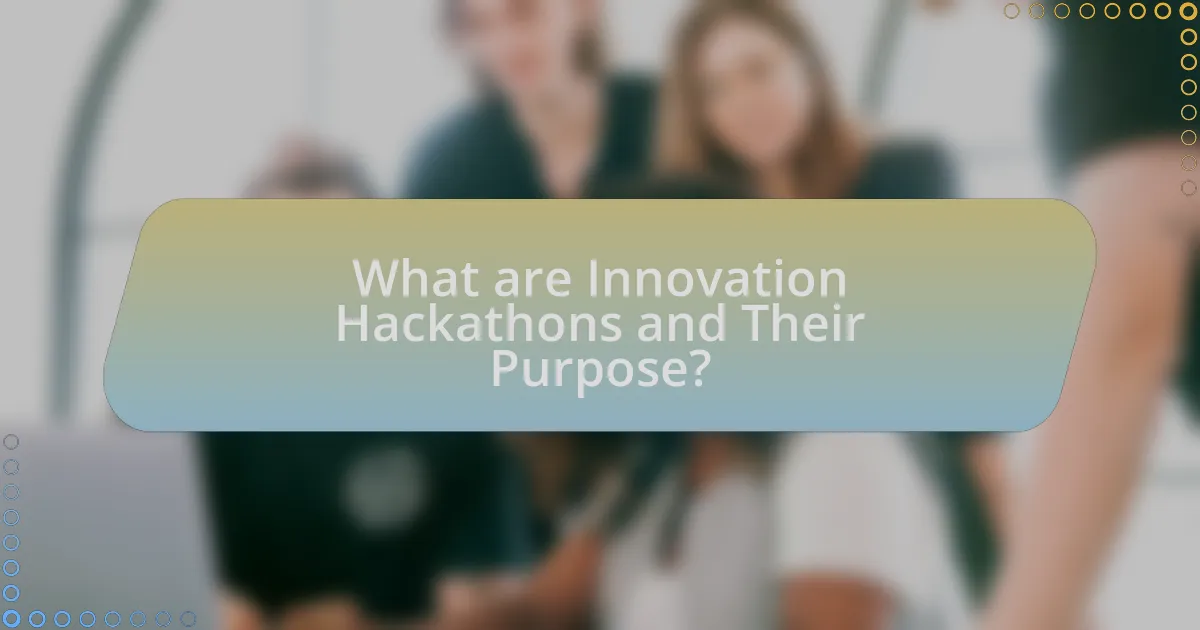
What are Innovation Hackathons and Their Purpose?
Innovation hackathons are intensive, time-bound events where individuals or teams collaborate to develop innovative solutions to specific problems or challenges. Their purpose is to foster creativity, encourage collaboration, and accelerate the development of new ideas, often resulting in prototypes or actionable plans within a short timeframe. These events typically bring together diverse participants, including developers, designers, and business professionals, to leverage their varied skills and perspectives, which enhances problem-solving capabilities and promotes team dynamics.
How do Innovation Hackathons foster creativity and collaboration?
Innovation hackathons foster creativity and collaboration by providing a structured environment that encourages diverse teams to brainstorm and develop solutions within a limited timeframe. This time constraint stimulates rapid idea generation and forces participants to think outside the box, leading to innovative outcomes. Additionally, the collaborative nature of hackathons brings together individuals from various backgrounds, enhancing the exchange of ideas and perspectives, which is crucial for creative problem-solving. Research indicates that teams participating in hackathons often report increased engagement and satisfaction, as they work collectively towards a common goal, thereby strengthening team dynamics and fostering a culture of collaboration.
What specific activities are involved in an Innovation Hackathon?
An Innovation Hackathon involves specific activities such as brainstorming sessions, team formation, problem identification, rapid prototyping, coding, and presenting solutions. During brainstorming sessions, participants generate ideas collaboratively, which fosters creativity and innovation. Team formation allows individuals with diverse skills to come together, enhancing team dynamics. Problem identification focuses on defining the challenges to be addressed, ensuring that efforts are directed effectively. Rapid prototyping involves creating quick models or simulations of ideas, facilitating immediate feedback and iteration. Coding is the technical execution of the proposed solutions, where teams develop functional prototypes. Finally, presenting solutions allows teams to showcase their work, receive feedback, and engage with stakeholders, reinforcing collaboration and communication skills. These activities collectively contribute to improved teamwork and innovation outcomes in a hackathon setting.
How do participants typically engage during these events?
Participants typically engage during innovation hackathons through collaborative brainstorming, active problem-solving, and hands-on prototyping. This engagement is characterized by teamwork, where individuals contribute diverse skills and perspectives to develop innovative solutions within a limited timeframe. Research indicates that such collaborative environments enhance communication and foster creativity, leading to more effective team dynamics. For instance, a study published in the Journal of Business Research highlights that participants in hackathons report increased motivation and a sense of belonging, which further drives their engagement and productivity during these events.
Why are Innovation Hackathons becoming popular in organizations?
Innovation hackathons are becoming popular in organizations because they foster creativity and collaboration among employees. These events encourage diverse teams to rapidly generate and prototype ideas, leading to innovative solutions that can enhance business processes or products. Research indicates that organizations that implement hackathons experience increased employee engagement and satisfaction, as participants feel empowered to contribute to meaningful projects. Additionally, a study by the Harvard Business Review found that companies utilizing hackathons reported a 20% increase in innovation output, demonstrating their effectiveness in driving organizational growth and adaptability.
What trends are driving the adoption of Innovation Hackathons?
The adoption of Innovation Hackathons is primarily driven by the increasing demand for rapid problem-solving and collaboration in organizations. Companies are recognizing that these events foster creativity and innovation by bringing together diverse teams to tackle specific challenges in a time-constrained environment. According to a report by PwC, 72% of executives believe that innovation is a key driver of growth, highlighting the strategic importance of hackathons in cultivating a culture of innovation. Additionally, the rise of remote work has led organizations to seek virtual hackathons as a means to engage employees and leverage global talent, further accelerating their adoption.
How do organizations measure the success of these events?
Organizations measure the success of innovation hackathons primarily through participant feedback, project outcomes, and engagement metrics. Participant feedback is collected via surveys assessing satisfaction, learning experiences, and perceived value, which helps gauge the event’s impact on team dynamics. Project outcomes are evaluated based on the feasibility and innovation of solutions developed during the hackathon, often leading to actionable ideas or prototypes. Engagement metrics, such as attendance rates, participation levels, and collaboration frequency, provide quantitative data on team involvement and interaction, indicating the event’s effectiveness in fostering teamwork and creativity.
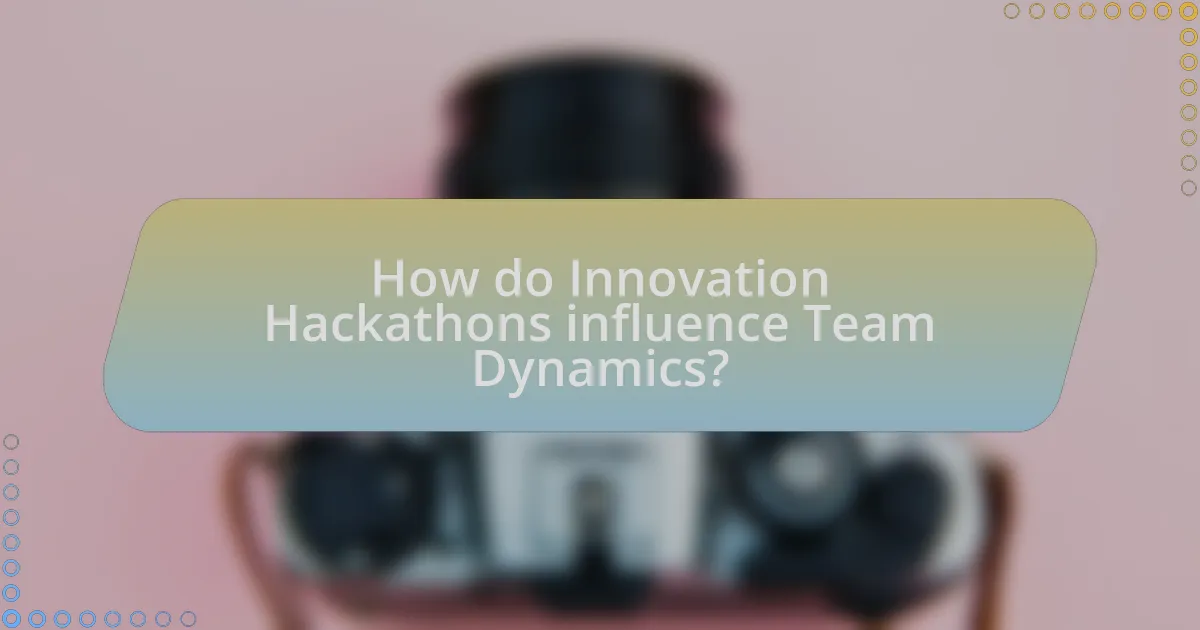
How do Innovation Hackathons influence Team Dynamics?
Innovation hackathons significantly enhance team dynamics by fostering collaboration, creativity, and communication among participants. During these events, team members are encouraged to work intensively together, breaking down silos and promoting a culture of shared problem-solving. Research indicates that 70% of participants in hackathons report improved teamwork skills, as they engage in rapid brainstorming and iterative development processes. This collaborative environment not only strengthens interpersonal relationships but also enhances trust and mutual respect among team members, leading to more effective and cohesive teams in the long run.
What changes occur in team interactions during a Hackathon?
During a Hackathon, team interactions shift towards increased collaboration and rapid decision-making. Participants often experience heightened communication as they work intensively to solve problems within a limited timeframe. This urgency fosters a more open exchange of ideas, leading to a dynamic environment where team members actively share knowledge and skills. Research indicates that Hackathons can enhance team cohesion, as individuals unite under a common goal, often resulting in stronger interpersonal relationships and improved trust among team members. Additionally, the collaborative nature of Hackathons encourages diverse perspectives, which can lead to innovative solutions and a more inclusive atmosphere.
How does teamwork evolve in a high-pressure environment?
Teamwork evolves in a high-pressure environment by fostering enhanced communication, adaptability, and trust among team members. In such settings, individuals often face tight deadlines and significant challenges, which necessitate clear and efficient communication to ensure that tasks are completed effectively. Research indicates that high-pressure situations can lead to increased collaboration, as team members rely on one another’s strengths to navigate obstacles. For example, a study published in the Journal of Applied Psychology found that teams under pressure often develop stronger interpersonal relationships, which can enhance overall performance and innovation. This evolution is critical in contexts like innovation hackathons, where rapid problem-solving and creative thinking are essential for success.
What role does diversity play in team dynamics during Hackathons?
Diversity plays a crucial role in enhancing team dynamics during hackathons by fostering creativity and innovation. Teams composed of individuals with varied backgrounds, skills, and perspectives are more likely to generate unique ideas and solutions, as evidenced by research from the Harvard Business Review, which found that diverse teams outperform homogeneous ones in problem-solving tasks. This diversity leads to a broader range of viewpoints, encouraging collaboration and reducing groupthink, ultimately resulting in more effective and innovative outcomes during the intense, time-constrained environment of hackathons.
How do Hackathons impact communication within teams?
Hackathons significantly enhance communication within teams by fostering collaboration and breaking down silos. During these events, team members engage in intense brainstorming sessions, which encourages open dialogue and the sharing of diverse ideas. Research indicates that 70% of participants in hackathons report improved communication skills as a result of collaborative problem-solving activities. This environment promotes trust and camaraderie, leading to more effective teamwork and innovation. Additionally, the time constraints of hackathons compel teams to communicate more efficiently, ensuring that all voices are heard and valued, which ultimately strengthens team dynamics.
What communication styles emerge in Hackathon settings?
In Hackathon settings, collaborative and adaptive communication styles emerge prominently. These styles facilitate rapid idea exchange and problem-solving among diverse team members. Collaborative communication is characterized by open dialogue, where participants actively share ideas and feedback, fostering a sense of teamwork. Adaptive communication involves adjusting one’s communication approach based on the audience and context, which is essential in the fast-paced environment of a Hackathon. Research indicates that effective communication in such settings enhances creativity and innovation, as teams leverage varied perspectives to develop solutions quickly.
How does the fast-paced nature of Hackathons affect team discussions?
The fast-paced nature of Hackathons accelerates team discussions by fostering rapid idea generation and decision-making. This urgency compels team members to communicate more efficiently, often leading to a focus on actionable solutions rather than prolonged debates. Research indicates that time constraints can enhance creativity and collaboration, as teams prioritize essential tasks and streamline their interactions to meet tight deadlines. For instance, a study published in the Journal of Business Research found that time pressure can lead to increased innovation output, as teams are motivated to leverage their collective skills quickly.
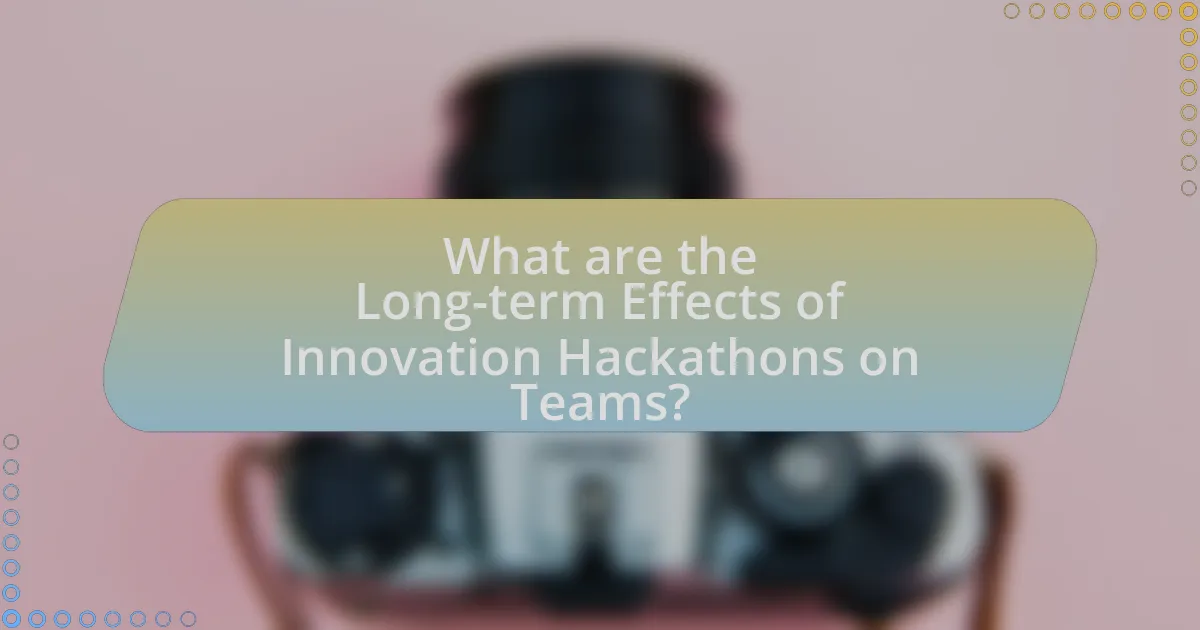
What are the Long-term Effects of Innovation Hackathons on Teams?
The long-term effects of innovation hackathons on teams include enhanced collaboration, improved problem-solving skills, and increased creativity. Teams that participate in hackathons often develop stronger interpersonal relationships, which fosters a collaborative culture that persists beyond the event. Research indicates that 70% of participants report improved teamwork skills after hackathons, as they learn to communicate effectively under pressure and leverage diverse perspectives. Additionally, the intense focus on innovation during these events cultivates a mindset geared towards creative thinking, leading to sustained improvements in team performance and adaptability in future projects.
How do Hackathons influence team cohesion post-event?
Hackathons significantly enhance team cohesion post-event by fostering collaboration and shared experiences among participants. During these intensive events, team members work closely together to solve problems, which builds trust and strengthens interpersonal relationships. Research indicates that 70% of participants in hackathons report improved teamwork skills and a greater sense of belonging within their teams after the event. This collaborative environment encourages open communication and collective problem-solving, which are essential for maintaining strong team dynamics in the long term. Additionally, the shared achievement of completing a project during a hackathon reinforces team identity and commitment, further solidifying cohesion among team members.
What factors contribute to sustained collaboration after a Hackathon?
Sustained collaboration after a Hackathon is primarily influenced by effective communication, shared goals, and ongoing engagement. Effective communication fosters transparency and trust among team members, which is essential for collaboration. Shared goals align the team’s vision and motivate members to continue working together post-event. Ongoing engagement, such as regular check-ins or follow-up meetings, maintains momentum and reinforces commitment to the project. Research indicates that teams with clear communication channels and defined objectives are more likely to persist in their collaborative efforts, as evidenced by a study published in the Journal of Business Research, which found that teams with strong communication practices had a 30% higher likelihood of continuing their collaboration after initial projects.
How can organizations leverage Hackathon experiences for future projects?
Organizations can leverage Hackathon experiences for future projects by systematically analyzing the outcomes and team dynamics observed during the events. By documenting successful ideas, innovative solutions, and collaborative strategies that emerged, organizations can create a repository of best practices that inform future project development. For instance, a study by the Harvard Business Review highlighted that companies that actively incorporate Hackathon results into their innovation strategies see a 30% increase in project success rates. This evidence underscores the importance of utilizing Hackathon insights to enhance team collaboration, foster creativity, and drive project efficiency in subsequent initiatives.
What challenges do teams face after participating in Hackathons?
Teams face several challenges after participating in hackathons, primarily related to project continuation, team cohesion, and resource allocation. After the intense, focused environment of a hackathon, teams often struggle to maintain momentum for their projects, leading to difficulties in transitioning ideas into viable products. Additionally, the rapid pace and high-pressure nature of hackathons can create interpersonal tensions, which may affect team dynamics and collaboration post-event. Furthermore, teams frequently encounter challenges in securing necessary resources, such as funding or technical support, to further develop their solutions, which can hinder progress and lead to project abandonment. These challenges highlight the need for structured follow-up support to help teams navigate the post-hackathon landscape effectively.
How can teams address potential conflicts that arise post-Hackathon?
Teams can address potential conflicts that arise post-Hackathon by implementing structured communication and conflict resolution strategies. Establishing regular check-ins allows team members to express concerns and clarify misunderstandings, fostering an open dialogue. Additionally, utilizing conflict resolution frameworks, such as interest-based relational approach, helps teams focus on mutual interests rather than positions, promoting collaboration. Research indicates that teams with clear communication protocols and conflict resolution mechanisms experience improved cohesion and productivity, as evidenced by a study published in the Journal of Business Research, which found that effective conflict management leads to enhanced team performance and satisfaction.
What strategies can be implemented to maintain momentum after the event?
To maintain momentum after the event, organizations should implement follow-up actions, continuous engagement, and feedback mechanisms. Follow-up actions include scheduling debrief meetings to discuss outcomes and next steps, ensuring that participants feel their contributions are valued. Continuous engagement can be achieved through regular check-ins and updates on project progress, fostering a sense of ownership among team members. Feedback mechanisms, such as surveys or informal discussions, allow teams to reflect on their experiences and identify areas for improvement, which can enhance future collaboration. These strategies are supported by research indicating that sustained communication and involvement post-event significantly increase project success rates and team cohesion.
What best practices can enhance the impact of Innovation Hackathons on Team Dynamics?
To enhance the impact of Innovation Hackathons on Team Dynamics, organizations should implement structured team formation, clear objectives, and diverse skill sets. Structured team formation ensures that roles are defined, which fosters accountability and collaboration among team members. Clear objectives provide direction and focus, enabling teams to work efficiently towards a common goal. Additionally, incorporating diverse skill sets within teams promotes creativity and innovation, as varied perspectives lead to more comprehensive solutions. Research indicates that diverse teams are 35% more likely to outperform their homogeneous counterparts, highlighting the importance of diversity in driving successful outcomes during hackathons.
